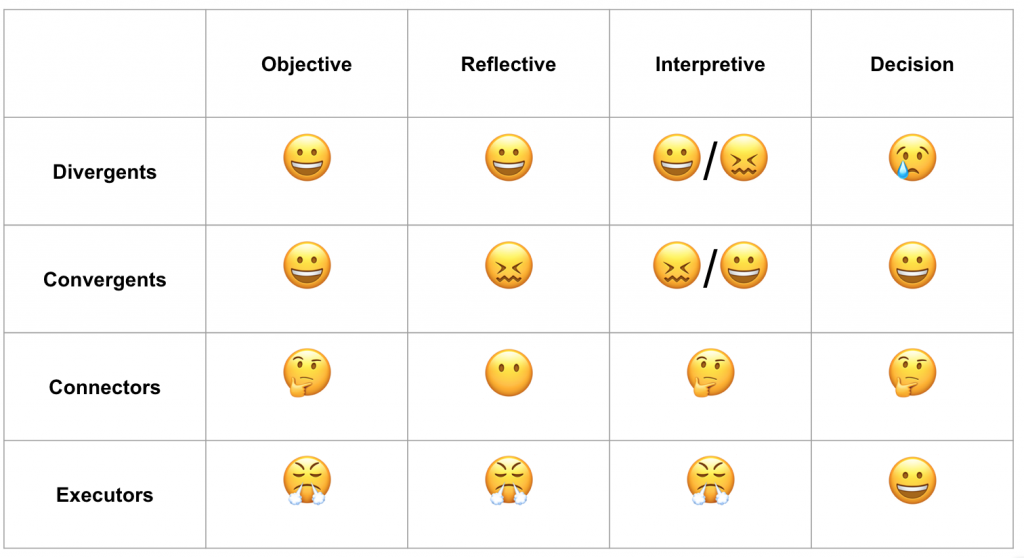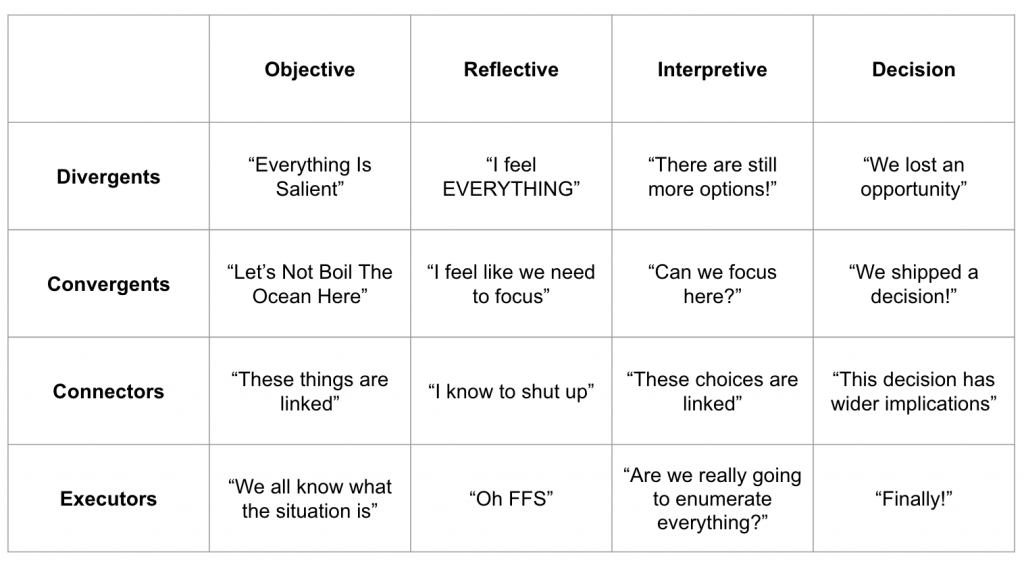The Humanity of Productive Meetings
This post is a continuation of The Technology of Productive Meetings from November 2019. Below, you’ll find a summary two frameworks: ORID and Stances, before extending it further. This post is intended for those on the human side of data science. Carbon is harder than silicon.
Summary
The ICA teaches a group facilitation method that features the ORID framework.
The ORID (Objective, Reflective, Interpretive, Decision) framework offers a path for a group of individuals to ship a decision. While the facilitator helps the group through the steps, it is the group itself that ships the decision. The method acknowledges the way people feel their way through a decision. The facilitator crafts a sequence of questions which match each one of those phases. People contribute facts during the Objective phase. People contribute reactions, reflections, and feelings during the Reflective phase. People contribute their ideas, and participate in the synthesis during the Interpretive phase. People contribute their consent during the Decision phase.
In the Fifth Discipline Fieldbook (Chapter 8), Ross, Smith and Roberts draw on Kolb to explain why people learn the way they do. I crossed those ideas with what James March taught us in 1981, talked to a whole lot of you (thank you!) about your experiences, and simplified it down to four stances: Divergent, Convergent, Connectors, and Executors. Divergents are always coming up with new ideas. Convergents want to synthesize the material into a position. Connectors see how systems and ideas click together. Executors love to execute and do.
Mash them together and we get a 4×4 matrix.
A Four By Four
I’ll put the independent variable along the top of the matrix, and the dependent variable along the side. The facilitator is a force of nature, helping the group move through the phases of a meeting. Something is happening to each segment during each phase – Divergents, Convergents, Connectors, and Executors. The emoji’s are a prediction of what it might feel like to be in each phase, as it happens to them.

And here are some things that maybe each segment says to themselves as they experience the meeting.

It might seem as though the ORID Group Facilitation method privileges Divergents. From the outset, they get to expand the boundaries of a problem space to a huge field. They get to enumerate all their feelings. There is no limit on the number of stickies they get to write out during the Interpretive phase. Life must be good as a Divergent in the ORID structure.
And then something terrible happens to them.
The facilitator helps the group collapse the options into viable options that can be decided on. This marks the end of the divergence and the beginning of the convergence. This is when it goes from being blue sky and the sky is the limit, down into a choice space. For them, it’s no longer play. The fun is over. The pool is closed.
The Decision phase is especially brutal. There’s a feeling that the group missed something. That there was something better. If we only had more time. And often, in the end, there’s a kind of resigned consensus. That while they disagree with the decision to decide on that particular option, they agree that the decision is generally good for the organization. They still think that we needed more time though. But fine.
The formal facilitation training instructs the facilitator to head on back to the Reflective phase every time somebody starts up with the reactions until they’re all gone.
The Convergents may experience the facilitation differently. Usually, there’s generally tolerance to the enumeration of a dozen or so facts. It’s the raw material they can use to synthesize. By the end of the Objective portion they often feel as though they have enough to go on.
And then the Reaction phase begins. This is often fine at first. And then it gets to be too much. And they’re in this state of frustration until the converging point happens. A convergence, they’re happy because they’re doing what they love. They’re synthesizing down towards a solution. They’re generally happy so long as a decision pops out at the end.
Connectors experience the facilitation differently. Some of the tools in the facilitators box, in particular the use of stickies for brainstorming, is designed to let them express ideas. The pattern matching technique during convergence in the Interpretive phase maximizes their gift so long as they have the space to do it. For many reasons, they learn to shut up during the reflective phase. Once a decision is shipped, they think about the connections to other systems. They’re never sure if they can be happy.
Executors experience frustration until a decision is reached. Executors are at their happiest doing. They experience joy at the delivery of a decision.
A Fistful Of People
A roomful of Executors will ship a decision very rapidly.
A roomful of Divergents won’t ship anything. They’ll talk to each other until the heat death of the universe.
A roomful of Convergents will ship the most obvious decision.
A roomful of Connectors will eventually ship a system of decisions, often not the decision originally asked for, but related in a strangely passive-aggressive way towards what they generally agree is the root cause of the whole problem field.
The best rooms have representation from each segment.
A roomful of Executors, Divergents, Convergents, and Connectors will ship the best decisions.
Divergents need Convergents to converge.
Convergents needs Divergents for fuel.
Both need Executors to marshal them along through the swamp.
Connectors need Divergents to spray the walls with stickies, Convergents to ultimately write slogans for the decision, and Executors to keep the momentum of the meeting going.
Executors need something to execute, and especially need their Connectors to help bridge the divides and maintain cohesion.
They all need each other to get the best from each other.
Really great insights happen when facts and feelings are organized and made evident.
What’s Changing
The amount of complexity that leaders in data science in particular, and machine learning / machine intelligence in general has to manage is increasing. With that complexity comes more specialization and more teaming. This adds up in an increase in cognitive diversity in more spaces.
Since planning is a form of learning, and we’re spending a lot more time in planning, the number and variety of decisions we have to ship together is only going to increase.
What It Means
What it means for facilitators is, perhaps, a more effective way to get humans through a decision, humanely.
What it means for you, as a participant experiencing the independent variable of facilitation and the inevitable joy and grind through ORID, depends on your dominant cognitive style, and your ability to play.
It may be a bit like professional sports entertainment wrestling. Your real self may be an Executor but what might it feel like to play the role of a Diverger? Could you ever dress up like Macho Man Randy Savage and play that role? Could you ever suspend disbelief and play in each phase as though you were something else? What would that be like?
Could it make meetings more productive?
Could it make the quality of the decisions shipped that much better?
